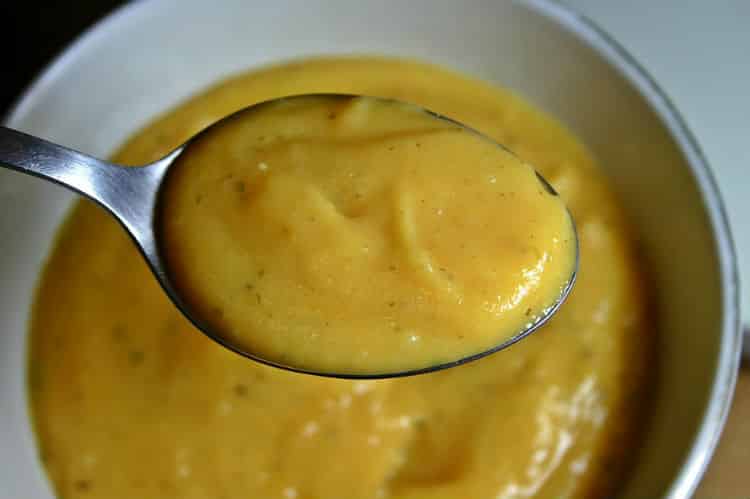Don’t forget to read about storing purées in the previous entry: Storing Baby Purées
Updated article: April 2022.
Before Serving
Before serving a purée to a baby, you have to check its temperature on your inside wrist or top of your hand. You should, at most, feel warmth or nothing on contact to ensure that the temperature is fine for your baby.
When to Serve the Meal
Milk (breast or commercial) is essential, a priority for their growth for a child under one year of age. However, it’s important to note that we shouldn’t give them milk just before the meal, as many children will refuse solids as they’re already full of milk. That said, if the baby eats well, their growth curves are good, and they drink before the meal, you should continue!
If your baby drinks a lot and eats little, it’s important that they consume their milk at least 1–2 hours before the meal. After eating solids, offer them milk to complete their meal. Over the course of a day, their milk intake will suffice.
Serve purées to your baby based on your meals, especially when they’re eating three times a day. The family can eat together and share time talking about their day, and it’s magical! The baby learns and acts through imitation. They will probably eat more and better with you.
Purée Quantities to Serve to a Baby
 Ensuring your baby’s satiation is vital. If your baby’s growth curves are good for both weight and height, the baby is eating enough.
Ensuring your baby’s satiation is vital. If your baby’s growth curves are good for both weight and height, the baby is eating enough.
You have to recognise the signs of satiety in your baby, such as:
- They lean their head back;
- They close their mouth;
- When they turn their head to the side.
At about eight months, you can expect a baby to eat from all food groups, eating pieces of food. They should continue to drink about 750 ml of milk from their mother or bottle. After eight months, the quantity of milk will diminish naturally and will stabilise around 12 months.
When we talk about food quantities, you have to consider the health situation of your baby. If they have a health issue, such as a cold, earache or just had a vaccination, it’s normal they will eat less for a short period.
Some babies eat a lot, and parents worry about overeating, thinking their baby has no limits with food. Each child is unique, their genes, the stages of their development, their growth spurts…this can vary the baby’s food intake. It’s all about ensuring your baby’s satiation.
If they’re growing well, their weight and height curves are good, the energy intake is adequate. However, it remains important to concentrate on the quality of the food choice offered to provide all the elements required for your baby’s growth and development.
A baby’s iron needs are essential. It’s recommended to offer them foods rich in iron twice a day and gradually increase it to three times a day with the number of meals they eat.
Food variety is also significant. You can start by offering babies one choice of food per meal and gradually increase it to provide full meals, which include 3–4 food groups at around 9 to 12 months. These things can help you know if your baby is eating enough.
If your baby has been eating less over the past couple of weeks, or they have become fussy and they eat a tiny range of foods, or if they’re losing weight, consult a health professional.
Baby Refuses to Eat
 If the baby refuses to eat a food, don’t force them. However, don’t always give them food they prefer. You have to continue to use strategies to mix the foods they like with others more difficult to introduce. You have to try to get them to accept it over the long-term. This means persevering and trying without being too insistent.
If the baby refuses to eat a food, don’t force them. However, don’t always give them food they prefer. You have to continue to use strategies to mix the foods they like with others more difficult to introduce. You have to try to get them to accept it over the long-term. This means persevering and trying without being too insistent.
To incorporate allergens, here are some ideas:
- For peanut butter or nut butter, it can be diluted in about ½ to 1 tsp. of baby’s milk or warm water to accustom him to a smoother and less sticky texture or you can take peanut or nut powder that can be mixed with his cereal, compote or his mashed vegetables with no problem.
- For eggs, the ideal is to introduce it into a recipe that requires cooking, such as muffins or pancakes for example. It can also be served as a scrambled egg, diluted with his milk and heated in the microwave for cooking.
- Natural silken tofu can be mixed with fruit purees for its introduction without the baby realizing it. You can also crumble it and mix it with your vegetable purees.
- For fish, you can mash them in a little bit of milk if necessary and if the flesh is too hard, you can put it in a food processor with another food to have a less stiff texture to chew.
Taste development includes several stages, and each baby is different. Children have more taste buds than adults, and their taste is more sensitive.
It’s not recommended distracting them to get them to eat or force them to eat. Check out this interesting reference: À nos marmites : 1, 2, 3… Santé!
With babies older than six months who refuse purée, you can try baby-led weaning, which usually leads to good results, as the baby will pick up small pieces of food to put in their mouth. You can watch the live video about baby-led weaning with occupational therapist Catherine Cusson (in french).
You can also play with the presentation to get your baby to collaborate when eating. You can use different colours, textures and give them both foods they like a lot and foods they want less.
 Phew! Introducing solid foods is an essential stage in your baby’s life. For some parents, it will go well, and for others, well, it will require much patience! To help you during this stage, I suggest you print the Introducing Solid Food to an Infant guide and stick it to the fridge where you can consult it and check off foods you have already introduced them to.
Phew! Introducing solid foods is an essential stage in your baby’s life. For some parents, it will go well, and for others, well, it will require much patience! To help you during this stage, I suggest you print the Introducing Solid Food to an Infant guide and stick it to the fridge where you can consult it and check off foods you have already introduced them to.
This entry has brought together the essential information to guide you in making and managing homemade purées for babies. Trust the process. There’s always a first time for everything, and making purées is just one. Don’t worry if they’re not perfect the first time, they’ll be better next time—all you can do is improve 😊!
To inspire you, read the next entry on Super Recipes for Homemade Baby Purées with all the recipes used in the video about baby purées.
Let’s cook!
Marie
The Baby Expert


